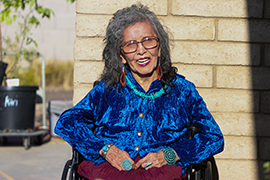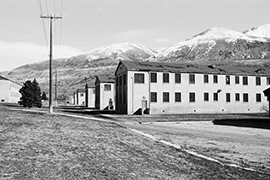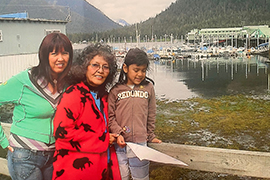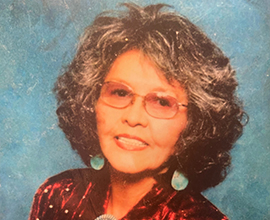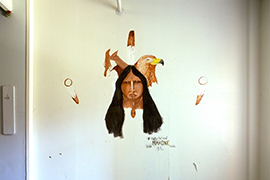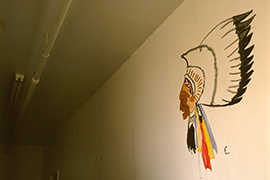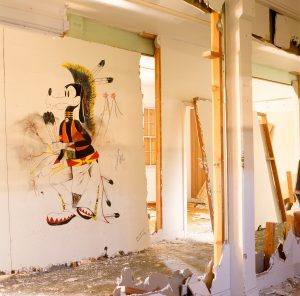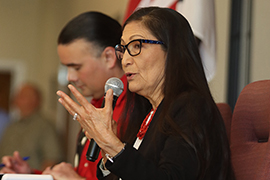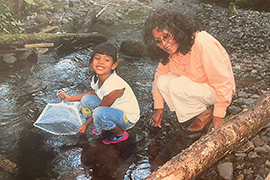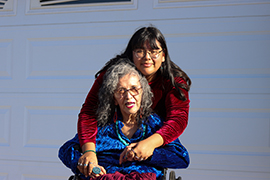- Slug: BC-CNS-Boarding School Generations,2860 words.
- 10 photos, video story, audio file available (thumbnails, captions below).
By Sierra Alvarez
Cronkite News
“Where are my people?” The mountains cry out. “I’ve seen them play and live in my hands,
And I’ve felt them run the trail of my back.
Before the sleepy winter came, I heard their laughter
Ring out and fill the valleys with joy.
Now there’s only the sound of silence where
Once a baby had talked in meaningless sentences.
Mr. Sun, you’ve traveled, do you know where my people are?”
A drop of golden sunshine was the answer.
“Have you seen my people?” the mountains ask the sky.
But the rains came, and that was the sky’s reply.
– Henry Tinhorn, former student at Intermountain Indian School (1970)
Chapter 1. Leaving home, losing self
A little girl, around 10 years old, is forced to leave her home she calls a hogan. She doesn’t bring much except the dress she was wearing and about 50 cents in her pocket. Her mother, father and grandparents watch her ride away in a car for the very first time. She is sent away in silence.
She arrives where other buses are prepared to leave. The little girl notices children who look like her but they don’t speak to one another. She looks in awe at everybody’s suitcases and beautiful clothes. Nonetheless, they all enter the same Greyhound bus together.
Once they are all boarded, the bus starts and terrifies the children — they’ve never heard anything like it in their lives. All the children are greeted in a foreign language and given directions they don’t understand. They never expected what was to come.
“I didn’t know where I was going. Pretty soon it got dark. Traveling all night. And some of us have to go potty. We didn’t know where the potty was,” Anita Yellowhair said.
It was 1950. Anita Yellowhair, of Arizona, was one of thousands of children taken from their home to one of more than 400 boarding schools in the U.S. where they would learn how to live the white man’s way – a way of life imposed onto Native Americans by white people that would strip them of their language, culture and identity in a government-sanctioned effort to assimilate them into Western culture.
Yellowhair, who is Navajo, spent 10 years of school at the Intermountain Indian School in Brigham City, Utah.
It left its mark. On Yellowhair. On my mother. And on me, her granddaughter. For years I didn’t know the depths to her story but now I am telling it. Years of my grandmother’s silence, now given voice, with steps toward healing.
My grandmother is a boarding school survivor.
Chapter 2. Traveling from hogan to boarding school
Yellowhair lived on the Navajo Nation reservation in a place called Steamboat. Here, her family lived off of sheep and hard work in a home called a hogan.
This hogan had dirt floors, no running water and no electricity for their small family. They relied on their sheep for food and traveled far for water.
Winters were hard for their family as it would be very cold, with only sheep skin to keep them warm.
Although this life may have seemed hard to some, Yellowhair was happy. She loved to spend time with her sheep and dogs as she lay in fields, feeling the wind on her face.
“I was happy the way life was,” Yellowhair said. “But then they said this is not a good life.”
“The white man pointed to his chest,” Yellowhair said. “He said, ‘Do you want to be like me?’ ”
Yellowhair was sent away to Intermountain Indian School, which became the largest Indian boarding school in the U.S.
At the time she was sent away, she spoke Navajo. Only English was allowed to be spoken at the school, but she didn’t even know what that was.
When she did choose to speak in her Native language she was punished.
“You have to wash the toilet all night or sit down the hall with your hand against the wall, with your knees on the floor. That’s a torture,” Yellowhair said.
Experts on Native boarding schools said abuse – emotional, physical and sexual – was common.
“Federal Indian boarding school rules were often enforced through punishment, including corporal punishment such as solitary confinement; flogging; withholding food; whipping; slapping; and cuffing,” according to an investigative report from the U.S. Department of the Interior.
Richard Henry Pratt, a former military officer and founder of Carlisle Indian School, described his philosophy of assimilation as “kill the Indian, save the man,” in an infamous speech delivered in 1892 during the National Conference of Charities and Correction in Denver.
The Smithsonian Institution said boarding schools, usually led by government officials or Christian missionaries, were established in the mid-19th century “to eliminate traditional American Indian ways of life and replace them with mainstream American culture.”
With the elimination of Native American culture over a century, the Native way of life was lost over time. Navajo itself is considered under UNESCO as a “vulnerable” language – only 175,000 people in the U.S. and elsewhere speak Diné.
I was never taught how to speak Navajo because my family wanted me to learn English and live my life the white man’s way. I never realized the importance of embracing my culture because, as a family, we had lost our way for so long that sometimes it feels as if it’s too late.
Chapter 3. Breaking the silence
My grandmother didn’t tell me much about her trauma at her boarding school mostly because I think she wanted to accept what had happened to her and not dwell on the past. Now that she’s older she has been more vocal about sharing her story with me. While she still hasn’t told me everything, what I do know now has been devastating for me to hear.
“I’m sure it was very traumatic for her and again she likes to shield us from her experiences,” Noel Alvarez, my mother and first-born daughter of Anita Yellowhair, said. “Because I’m sure there were a lot of worse things that happened to her that she won’t tell us about.”
The silence surrounding Native American history has been a recurring theme.
“In addition to present-day educational disparities, Native American history is neglected in most K-12 classrooms. In fact, many students are actually surprised to learn that Native peoples still exist,” history professor Joshua Ward Jeffery wrote in a 2021 article in Education Week.
“Many non-Native students assume Native people must have died off since they largely disappear from textbook narratives after the 1890s. (They also make up about 1 percent of the national student population, so it’s possible that many non-Native students might not have been exposed to their Native peers),” wrote Jeffery, an assistant professor of history and Diné studies at Navajo Technical University.
Even as the history is ignored, trauma seeps into generations of families, experts said.
Dr. George “Bud” Vana, a psychiatrist, said it has a name: Indigenous historical trauma. It reflects experiences Indigenous people have felt due to colonization and the lasting scars that have left more problems for them to handle, even generations later.
“And we know that the process of colonization meant forced moves in forms of slavery, forms of physical, emotional, and sexual abuse that were perpetrated by colonizers,” Vana said.
Maria Yellow Horse Brave Heart led the research on Indigenous historical Trauma, other researchers note.
“That includes worse physical health, worse mental health, increased rates of substance use problems. Indigenous historical trauma really increases all these downstream effects,” Vana said.
Decades after Indian boarding schools have largely been closed, “the legacy of Indian boarding schools remains,” Interior Secretary Deb Haaland wrote in the investigative report, “manifesting itself in Indigenous communities through intergenerational trauma, cycles of violence and abuse, disappearance, premature deaths, and other undocumented bodily and mental impacts.”
The May 2022 Interior Department report on boarding schools estimates the breathtaking reach: Between 1819 and 1969, the U.S. operated or supported 408 Indian boarding schools across 37 states or territories that targeted American Indian, Alaska Native and Native Hawaiian children.
“Many who survived the ordeal returned home changed in unimaginable ways, and their experiences still resonate across the generations,” Haaland wrote.
Chapter 4. Navigating the complexities of boarding schools
Boarding school was a life full of complexities – students who were stripped of culture and identity while gaining a good education.
Yellowhair became a dental assistant after graduating from Intermountain Indian School in 1960. She ended up working for Dr. Bill Thomas, the only dental officer for the U.S. Public Health Service Indian Hospital at the time, for more than a year in Winslow.
She and Thomas became good friends. Yellowhair would teach Thomas about her culture.
“She was such a joy to be with. We just immediately clicked and she very quickly became a part of our family,” Thomas said. “She worked so well with people. She was so friendly and honest. Very clean and neat.”
Thomas and his wife, Janet, treated Yellowhair like their own daughter, spending time together even after she no longer worked as his dental assistant.
Yellowhair would never tell him much about her boarding school trauma, but he has mixed feelings about the schools.
“She had a pretty tough life,” Thomas said.
Intermountain, like other boarding schools, was full of contradictions and changes over the decades. An online timeline at one Utah museum, shows how students painted murals, celebrating Native identities, on walls of the school before it was closed in 1984.
Artist Sheila Nadimi has spent 25 years on her Eagle Village project, where she has visually tracked the site of Intermountain Indian School from 1996 to 2021.
Nadimi has photographed the remnants of the school, from the infrastructure to the murals left behind.
“The Intermountain Indian School that closed in 1984 was a very different school than the one that opened in 1950 and this has a lot to do with the students’ activism and agency to affect change,” Nadimi said.
The boarding school mission changed for Intermountain Indian School in its latter years from erasure of identity to embracing Native culture during its transitional period — when it moved from a school for Navajo students to going intertribal. By 1975, the renamed school was the largest boarding school in the world, drawing as many as 3,000 students from more than 100 tribes, according to the Smithsonian Institution.
Farina King, an author of “Returning Home: Diné Creative Works from the Intermountain Indian School,” touches on that shift. She notes that there are still dark moments within any period of this sort of education. She interviewed many Intermountain alumni about their experiences — good and bad.
She tells of one former Intermountain student who felt “like she could learn about herself and learn about the culture and Native American culture,” King said. “That’s something that I heard more in the later years at Intermountain – that people felt like this was a safe space for them to learn about their own Native goal.”
“Something sensitive about all this is that not one story is the final story about Intermountain. It doesn’t gloss over everything else, but it’s a piece of many that are a part of what happened at Intermountain,” King said.
King’s father attended an Indian boarding school: She notes that he does not call himself a “boarding school survivor.”
King’s father tried to escape his boarding school twice when faced with challenges. A rancher found him during a snowstorm.
“If he didn’t get saved, I know other stories of children trying to run away who froze to death. I would not exist if my dad wasn’t miraculously found and that hits me,” King said.
Intermountain Indian School closed its doors in 1984 and Utah State University built a campus over the remains of the school, which opened in 2015, but added a digital exhibit “ensuring that even when the dust from the ruined buildings settles, the important stories of what happened in this place will endure.”
There are now no remnants of Intermountain on its original grounds but other markers have risen.
Some school murals are being preserved at the Nora Eccles Harrison Museum of Art at Utah State. The Brigham City Museum of Art & History also has artifacts. And the Box Elder Museum of Art, History, and Nature provides a detailed, online exhibit of the Intermountain school from beginning to end.
And there’s another marking of memory – a giant white letter “I” fades away on a nearby mountain.
Intermountain alumni repaint the “I” every year.
Chapter 5. Reflecting and telling stories to heal
In summer 2022, Haaland began a year-long tour across tribal lands throughout the U.S. to hear the experiences of Native Americans who were sent to government-backed boarding schools. Haaland, a member of the Pueblo of Laguna tribe in New Mexico, wanted to use her position as Interior Secretary to address the shared experiences of former students at boarding schools and the intergenerational trauma those experiences caused.
She called it the “The Road to Healing,” with the first stop in Oklahoma. She came to the Gila River Indian Community in Arizona in January.
“To do that, we need to tell our stories,” Haaland wrote of the move to honor “Indigenous survivors of the federal Indian boarding school system and their descendants.”
She said the discovery that 53 boarding schools contain marked or unmarked burial sites was crucial to the department’s preliminary investigation, which lays the groundwork for a second report.
“As the investigation continues, we expect the number of identified burial sites to increase, along with the potential expansion or more definite numbers of identified Indian boarding school sites, children, and operating dates of facilities,” she said in a statement.
“That is part of America’s story that we must tell. While we cannot change that history, I believe that our nation will benefit from a full understanding of the truth of what took place and a focus on healing the wounds of the past,” Haaland said.
Vana, the psychiatrist, said there’s no one solution to the trauma endured by survivors.
“I think that we do know that cultural practices are really important to a lot of people and that helping people connect to those cultural practices is beneficial,” Vana said.
“I do want to encourage, in terms of what we can do as a sort of medical profession is we have to be trauma informed, to help patients understand when their symptoms may be the result of either specific trauma that they’ve experienced, or recognize the impact of trauma on their family members and loved ones, and how that then impacts them,” Vana said.
“Developing this trauma-informed lens, and trauma-informed practices, and that sort of starts with the person who greets you as you walk through the door as well.”
When King talked with Intermountain alumni, she hoped that, in some way, her listening to their stories helped them come to terms with what happened to them. She noted it’s important to understand that healing is complex for every person.
“I almost cry every time I talk about this, because I also think that a part of healing is that water is sacred, and talking sometimes about these hard things,” King said of her tears. “It helps us to understand lateral violence better and what we do about that. How can you ever heal a wound if you don’t even know it’s there and ignore it? A lot of them, especially how deep they are, don’t heal themselves without that help and attention they need.”
Yellowhair, my grandmother, is now 84 years old. More than a year ago, she first started telling me her story. She tells me that she still works to heal to this day. And she’s just one of thousands of Indigenous children who attended an Indian boarding school in the U.S.
“Finally, I get to that point. I’m old now. What’s the point? I still want to go back home. I never fully accepted the white man’s way but I still want to learn,” she said. “And I think to myself I’m not worried about that. I’m worried about my grandchildren losing their path, losing their way.”
Her legacy lives on with me and the rest of her family. She wishes the best for each of us in finding our own way of life.
“And for you, Sierra. I advise you. Find your happiness, find your path, find a way. Or else you’re just going to wander in the desert like I have been. I’m at the end of my trail. I still have things to say, to do,” she said. “Thank you for letting me talk about me. The bad things. I don’t want to tell you about all of those things. The good life is to find yourself.”
I have felt honored to tell my grandmother’s story and the stories of many others. While I cannot undo the trauma my grandmother suffered, what I can do is share her story with the world. It’s important to recognize Indigenous people’s voices, as we have endured much trauma historically and generationally.
And although we have endured many trials, Native people will always be strong and resilient.
While I got to tell my grandmother’s story through an online medium, many of our elders tell their stories orally. It’s important to listen to what they are saying.
Our elders are only on this place we call Earth for so long. Listen to their stories — and recognize the lessons they are trying to teach you.
For more stories from Cronkite News, visit cronkitenews.azpbs.org.
^__=
Anita Yellowhair is Navajo and a boarding school survivor. She is now 84 years old and lives in Mesa. (Photo by Logan Camden/Cronkite News)
These buildings served as dormitories for Intermountain Indian School, the largest Indian boarding school in the U.S.. The dorms were Bushnell General Military Hospital buildings that were then transformed into housing for Indigenous children. (Photo courtesy of Sheila Nadimi/Eagle Village Project)
Strength and resilience: Noel Alvarez, Anita Yellowhair and Sierra Alvarez, left to right. This mother, grandmother and daughter represent three generations of intergenerational trauma from Indian boarding schools. (Photo courtesy of Sierra Alvarez)
Three generations of Anita Yellowhair’s family, including her daughter, Noel Alvarez, left, and her granddaughter, Sierra Alvarez. Each generation has been impacted in some way by intergenerational trauma. (Photo by Logan Camden/Cronkite News)
Anita Yellowhair smiles for a picture in her cultural attire, including red velvet, with jewelry she’s crafted on her own. Turquoise is a stone significant to Native Americans. (Photo courtesy of Sierra Alvarez)
This was one of many murals left behind at Intermountain Indian School. The name “Holly Wood Mahone” is beneath the mural. (Photo courtesy of Sheila Nadimi/Eagle Village Project)
A mural of an Indigenous man in ceremonial headdress adorns a hallway of the former boarding school, Intermountain Indian School. (Photo courtesy of Sheila Nadimi/Eagle Village Project)
The interior of the Intermountain Indian School was mostly torn down, but a few murals like this one were left behind.(Photo courtesy of Sheila Nadimi/Eagle Village Project)
Interior Secretary Deb Haaland on the year-long “Road to Healing” tour across the U.S. to hear from Native Americans sent to government-backed boarding schools. Haaland said she wanted to address former boarding school students’ experiences and the intergenerational trauma they caused. (Photo by Paula Soria/Cronkite News)
Sierra Alvarez and her grandmother, Anita Yellowhair, traveled the country together in 2009. (Photo courtesy of Sierra Alvarez)
Anita Yellowhair and her granddaughter, Sierra Alvarez, who shared her grandmother’s story of being taken to a Utah boarding school as a child. (Photo by Logan Camden/Cronkite News)
